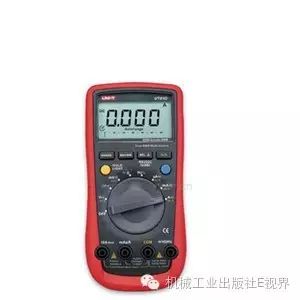 Follow our WeChat Subscription Number: Mechanical Industry Press E-World
Follow our WeChat Subscription Number: Mechanical Industry Press E-World
Long press the QR code above to recognize it and follow us!
A multimeter can measure direct current, direct or alternating voltage, and resistance. Some models can also directly measure capacitance, inductance, and transistor parameters. When repairing electrical and electronic equipment, a multimeter can quickly help locate and diagnose faults.
How to choose a suitable multimeter for home use?
How to choose a suitable multimeter for home use?

The multimeter for home use is mainly used for measuring and troubleshooting electrical circuits, electrical devices, electronic circuits, and electronic components. It should have suitable accuracy, stability, reliability, be economical and durable, easy to carry, and reasonably priced. Pocket-sized multimeters such as MF40, MF41, MF30, MF72 can be selected. These multimeters can also measure capacitance, inductance, and the gain β value of transistors. The MF30 model is a highly sensitive multimeter, while the MF72 model is particularly suitable for repairing televisions and tape recorders. Commonly used, highly sensitive multimeters include the 500 model, but it is larger and heavier with high precision. MF15, MF16 models also have relatively high sensitivity and are smaller, making them common multimeters for home use.

Digital multimeters are becoming increasingly popular among electricians due to their high sensitivity, comprehensive functions, intuitive display, good reliability, low power consumption, and compact size. Common models include DT-830. Its range switch can simultaneously complete testing functions and range selection.
When purchasing a multimeter, first observe the casing; it should be smooth and shiny, without scratches or cracks, and the scale on the dial should be clear and clean, without blemishes. Then rotate the range switch; it should be light and flexible, with no jamming or noise. Shake the multimeter horizontally a few times; the pointer should have good damping, and its swing should not be too large, with no knocking sounds inside the meter. Check the mechanical zero (the calibrator in the center position); see if the pointer can pass zero and accurately adjust to the zero point. Finally, check the battery on the multimeter in the ohm range: short the two probes, rotate the zeroing potentiometer in both directions, and the pointer should swing back and forth at “0” Ω, accurately adjusting to zero. If possible, check the product performance according to the manual to see if it meets the specified technical requirements.
-THE END-
Excerpt from 350 Questions on Home Electrical Renovation
Previous Highlights
Wiring Diagrams for Various Switches, No Need to Ask for Help!
Various Blunders Electricians Make at Work, Have You Experienced Them?
This Problem Often Confuses Many Experienced Electricians: The Difference Between Neutral Point and Zero Point, Zero Line!
Detailed Explanation of Electrician Skills: Low Voltage Distribution Box Wiring in Residential Buildings


↓↓↓

